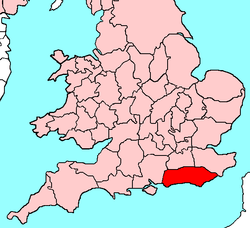History of Sussex
| Sussex | |
|---|---|

|
|
 Ancient extent of Sussex |
|
| Area | |
| • 1831 | 907,920 acres (3,674 km2) |
| • 1901 | 932,409 acres (3,773 km2) |
| Population | |
| • 1831 | 272,340 |
| • 1901 | 602,255 |
| Density | |
| • 1831 | 0.3 per acre (74/km2) |
| • 1901 | 0.6 per acre (150/km2) |
| History | |
| • Origin | Kingdom of Sussex |
| • Created | In antiquity |
| • Succeeded by | East Sussex and West Sussex |
| Status | Ceremonial county (until 1974) |
| Chapman code | SSX |
| • HQ | Chichester or Lewes |
| • Motto | We wunt be druv |
Sussex /ˈsʌsᵻks/, from the Old English 'Sūþsēaxe' ('South Saxons'), is a historic county in the south east of England. The foundation of the Kingdom of Sussex is recorded by the Anglo-Saxon Chronicle for the year AD 477, saying that Ælle arrived at a place called Cymenshore in three ships with his three sons and killed or put to flight the local inhabitants.
The foundation story is regarded as somewhat of a myth by most historians, although the archaeology suggests that Saxons did start to settle in the area in the late 5th century. The Kingdom of Sussex became the county of Sussex; then after the coming of Christianity; the see founded in Selsey, was moved to Chichester in the 11th century. The See of Chichester was coterminous with the county borders. In the 12th century the see was split into two archdeaconries centred at Chichester and Lewes.
Since its creation in the fifth century, Sussex has been subject to periodic reform of its local governance. After the Reform Act of 1832 Sussex was divided into the eastern division and the western division, these divisions were coterminous with the two archdeaconries of Chichester and Lewes. In 1889, following the Local Government Act 1888, using those same boundaries, Sussex was divided into two administrative counties, East Sussex and West Sussex together with three self-governing county boroughs, Brighton, Eastbourne and Hastings. In 1974, under the Local Government Act 1972, the county boundaries were revised with the mid-Sussex area of East Grinstead, Haywards Heath, Burgess Hill and Hassocks being transferred from East Sussex into West Sussex along with Crawley and the Gatwick area that was formerly part of Surrey. The county boroughs were returned to the control of the two county councils but in 1997 the towns of Brighton and Hove were amalgamated as a unitary local authority and in 2000, Brighton and Hove was given City status. Although it is administered as the two ceremonial counties of East and West Sussex, there continue to be a range of organisations that operate throughout the ancient borders of Sussex such as the Diocese of Chichester, Sussex Police, the Sussex Archaeological Society the Sussex History Society and the Sussex Wildlife Trust.
...
Wikipedia
